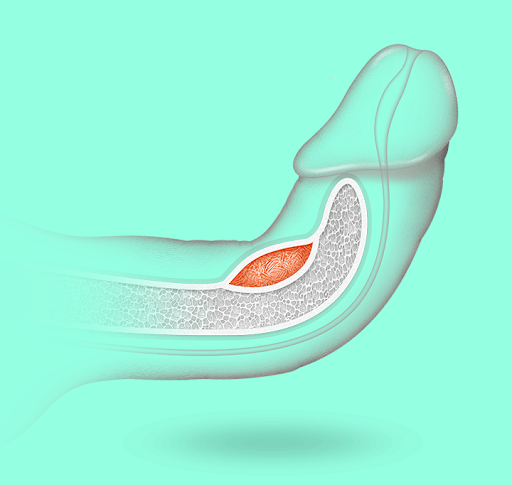What is Peyronie's disease?
Peyronie's disease, also known as Induratio Penis Plastica (IPP), is an acquired and generally progressive condition of the penis. Peyronie's disease affects about 4 out of 100 men between the ages of 40 and 70. It is caused by fibrous scar tissue that accumulates beneath the skin of the penis, known as plaque. Plaques form along one side (usually on the top). Many men with Peyronie's disease can still engage in sexual intercourse, but for some, it can be a very painful condition and can cause erectile dysfunction.
How does Peyronie's disease occur?
Urologists are not certain about the exact cause of Peyronie's disease. Researchers believe that the development of fibrous plaques may be due to genetics or trauma that causes bleeding inside the penis, which may be caused by contact sports or vigorous sexual intercourse. Injury to the tunica albuginea (the tough fibrous layer of connective tissue that surrounds the penis) can lead to the formation of scar tissue in the cells (fibrosis). This scar tissue then forms the plaque of Peyronie's disease.
Induratio Penis Plastica / Peyronie's disease
Induratio Penis Plastica (IPP), also known as Peyronie's disease, is an acquired and progressive condition of the penis. Most men notice the presence of the disease when they feel a thickened nodule (called a plaque) beneath the skin of the penis. As the condition progresses, pain can occur during an erection or when the penis is flaccid. Curvature of the penis during erection also occurs, making intercourse difficult or even impossible.

Causes
It is currently assumed that under certain conditions, abundant connective tissue deposits can form in the elastic sheath of the cavernous body of the penis.
This excessive accumulation of fibrous tissue in the lining of the corpus cavernosum leads to the formation of fibrous plaques.
Treatment of IPP with shock wave therapy
In the treatment of IPP/Peyronie's disease, we treat the formed plaque with Extracorporeal Shock Wave Therapy (ESWT). In a study on IPP treatment, shock waves were applied to the flaccid penis once a week for a period of four weeks. This led to a reduction in curvature and pain during erections.
The treatment lasts about 15 minutes. Typically, four sessions are performed, but depending on the severity and how the patient responds, the total number can be up to six sessions conducted once a week. The therapy is administered by Professor of Urology, Aleksandar Vuksanović.

Peyronie's disease and focal shockwave
Shock wave therapy for Peyronie's disease is a clinically proven treatment that can help treat erectile problems associated with the condition, and can also help permanently break down the fibrous plaques that cause penile flexion. When treating IPP, points of existing plaque in the penis are treated with focused shock waves.
In our clinic, this problem is solved through a series of 4 treatments, which are done once a week. Examination and treatment procedure for Peyronie's disease, done by a urologist from the urological clinic of the Clinical Center of Serbia, professor, PhD. med. Aleksandar Vuksanović.
